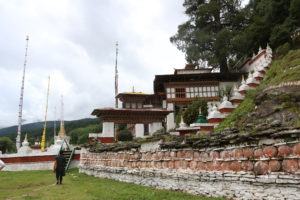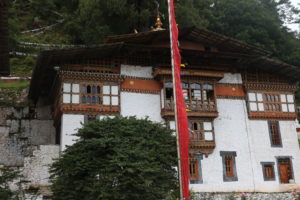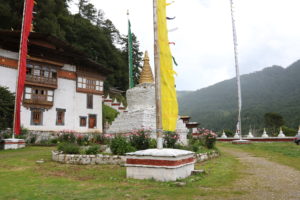Kurjey Lhakhang
Background
Made up of three separate buildings built by three different high-ranking government officials and royals, Kurjey Lhakhang stands magnificently in Jakar in the Chokor Valley of the Bumthang District. It is built on the side of a hill, with 108 stupas lining it. The first and oldest temple, called Guru Lhakhang, was built by Minjur Tenpa in 1652, while he was still serving as Trongsa Penlop, before he became the 3rd Desi. This temple is the most important of the three buildings as it houses the cave where Padmasambhava was believed to have meditated and left his body imprint. The second temple, Sampalundrup (also spelled Sampa Lhundrup) was also built by a Trongsa Penlop, although this one, Ugyen Wangchuck, would later go on to become the First King of Bhutan. Dedicated in 1900, Sampalundrup was built to house a massive statue of Guru Rinpoche. Finally, the third and most recent temple, Ka Gon Phur Sum Lhakhang, which translates to ‘The Three Mystic Revelations of the Eight Pronouncements’, was built by Queen Ashi Kesang Wangchuck, who was married to the Third King. Ka Gon Phur Sum Lhakhang was dedicated in 1990. In addition to its construction being the project of many members of the royal family, Kurjey Lhakhang is also the final resting place of the first three kings of Bhutan.

View of the temple upon entering.
Mythological Founding
In the 8thcentury, Bhutan was not yet a unified country, but rather an area ruled by many different regional kings. The country would not be unified until Zhabdrung traveled from Tibet and began teaching throughout the country, gaining political influence, and eventually establishing Bhutan as a united land in 1616. However, the introduction of Buddhism came long before the Zhabdrung’s arrival. In the 8thcentury, the Indian prince Sendha Gyab was sent into exile from India, eventually making his way into Bhutan and becoming the ruler of the Bumthang area. Once he became the ruler of the Bumthang area, Sendha Gyab took the title of Sindhu Raja, as he is more commonly referred to today. Because the country was made up of regional kingdoms, warring was common between the different kings. Sindhu Raja was known to often be in conflict with a king to the south, known only as Naochhe, or ‘Big Nose’. Before sending his troops—one of whom was his son—into war with Naochhe, Sindhu Raja prayed to (pre-Buddhist) local deities to protect his soldiers, specifically praying for the safety of his son. However, Sindhu Raja’s son was killed during the fighting, causing Sindhu to become resentful of the local deities. Sindhu then ordered his men to destroy religious sites, angering the local deities, especially the chief local protective deity, Shelging Karpo. Shelging Karpo thus aimed kill Sindhu Raja, stealing his ‘life essence’, or his soul. As a result, Sindhu Raja slowly became ill, unable to be healed by any of the astrologers or local shamans. As a final effort, one of Sindhu Raja’s ministers invited Padmasambhava, also known by the title Guru Rinpoche, to come from India, in hopes that he could heal Sindhu Raja. Guru Rinpoche’s supernatural powers were well known throughout the Himalayan region. Once he arrived in Bumthang in 746 A.D., Guru Rinpoche traveled to a cave above Sindhu Raja’s castle to meditate, which he did for three months and left his body imprint ‘kur jey’, giving the temple its name. Upon completion of his meditation, Guru Rinpoche sought to confront the local protective deity Shelging Karpo. As the Guru began to perform a ritual dance, all of the local deities came to watch, except for Shelging Karpo. Eventually, Guru Rinpoche and Shelging Karpo prepared to face off, with Shelging Karpo transforming into a white lion and Guru Rinpoche turning into a garuda (a mythical bird-like creature). Guru Rinpoche won the fight, and subdued Shelging Karpo as protector deity for Buddhism. With Shelging Karpo defeated, Sindhu Raja healed and converted to Buddhism. It is also believed that Sindhu Raja gave his daughter as a wife for Guru Rinpoche in gratitude. There is a tall cypress tree that was thought to have sprouted from Guru Rinpoche’s walking stick (sometimes referred to as a terma, or treasure) outside of the temple as well. Guru’s healing of Sindhu Raja and subjugation of the evil spirits signified the arrival of Buddhism in Bhutan.

Guru Lhakhang, the temple that houses the cave with Padmasambhava’s body imprint.
Modern Day Importance
One of the hallmarks of Bhutan is the deep connection between religion, history, and government that is so carefully preserved. Kurjey Lhakhang perfectly encapsulates this idea by being an important religious site, the place of the introduction of Buddhism into the country, and the final resting place of the first three kings of Bhutan. Although kings in Bhutan no longer hold absolute power, they are still important figures, highly venerated by citizens throughout the country. Kurjey Lhakhang is also an important Buddhist pilgrimage site. People travel to the temple to receive blessings, especially inside the small temple that houses the cave where Guru Rinpoche meditated for three months. Kurjey Lhakhang is also where Kurjey Tshechu is celebrated. Kurjey Tshechu is a one-day festival that usually takes place at the end of June or beginning of July each year (it takes place according to the Bhutanese lunar calendar). The Tshechu festival celebrates the teachings of Guru Rinpoche, making Kurjey Lhakhang a perfect venue. During the holy celebration, people typically practice the forms of dance introduced by the Guru, such as mask dances or the black hat dance. At the end of the festival, the large Buddha and Guru thongdrel (a special painting on top of a textile like cotton or silk) is unfurled. It is believed that watching the unfurling of this special thangka cleanses one of their sins.

One of the 108 stupas throughout the temple.
References
“Kurjey Lhakhang.” Bhutan Holidays. https://bhutanholidays.net/kurjey-lhakhang. Accessed 9 August 2018.
“Kurjey Lhakhang.” Bhutan Cultural Atlas. https://www.bhutanculturalatlas.org/606/culture/sites-structures/monasteries-temples/kurje-lhakhang/. Accessed 9 August 2018.
“Kurjey Lhakhang Complex.” Windhorse Tours. https://www.windhorsetours.com/sights/bhutan/Kurjey%20Lhakhang%20Complex.html. Accessed 9 August 2018.
Lonely Planet. “The Story of Kurjey Lhakhang.” Lonely Planet, pp. 210-212.
Tshering, Dorji. “The Soul and Substance of Bhutan’s Cultural Heritage.” National Museum of Bhutan, 2009. Accessed 9 August 2018.
Finally, thank you to our wonderful Professor Kevin Vose and our lovely tour guide Norzang Chhoeda for providing additional information and answering any questions about the site.
Megan Goyer